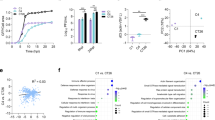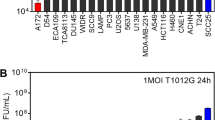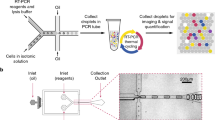Abstract
Replication-competent attenuated herpes simplex viruses have proven effective in killing many cancer cell lines. However, determinants of resistance to oncolytic therapy are mostly unknown. We developed viral therapy-resistant cells and examined changes in gene-expression pattern compared with therapy-sensitive parental cells. Colon cancer cell line HT29 and hepatoma cell line PLC5 were exposed to increasing concentrations of virus G207. Therapy-resistant cells were isolated and grown in vitro. Tumorigenicity was confirmed by ability of cell lines to form tumors in mice. Human Genome U133A complementary DNA microarray chips were used to determine gene-expression patterns, which were analyzed in the context of molecular network interactions, pathways and gene ontology. In parental cell lines, 90–100% of cells were killed by day 7 at 1.0 multiplicity of infection. In resistant cell lines, cytotoxicity assay confirmed 200- to 400-fold resistance. Microarray analysis confirmed changes in gene expressions associated with resistance: cell surface proteins affecting viral attachment and entry, cellular proteins affecting nucleotide pools and proteins altering apoptotic pathways. These changes would decrease viral infection and replication. Our study identifies gene-expression signatures associated with resistance to oncolytic viral therapy. These data provide potential targets to overcome resistance, and suggest that molecular assays may be useful in selecting patients for trial with this novel treatment.
This is a preview of subscription content, access via your institution
Access options
Subscribe to this journal
Receive 12 print issues and online access
$259.00 per year
only $21.58 per issue
Buy this article
- Purchase on SpringerLink
- Instant access to full article PDF
Prices may be subject to local taxes which are calculated during checkout




Similar content being viewed by others
References
Bennett JJ, Malhotra S, Wong RJ, Delman K, Zager J, St-Louis M et al. Interleukin 12 secretion enhances antitumor efficacy of oncolytic herpes simplex viral therapy for colorectal cancer. Ann Surg 2001; 233: 819–826.
Cozzi PJ, Malhotra S, McAuliffe P, Kooby DA, Federoff HJ, Huryk B et al. Intravesical oncolytic viral therapy using attenuated, replication-competent herpes simplex viruses G207 and NV1020 is effective in the treatment of bladder cancer in an orthotopic syngeneic model. FASEB J 2001; 15: 1306–1308.
Cozzi PJ, Burke PB, Bhargav A, Heston WD, Huryk B, Scardino PT et al. Oncolytic viral gene therapy for prostate cancer using two attenuated, replication-competent, genetically engineered herpes simplex viruses. Prostate 2002; 53: 95–100.
Delman KA, Bennett JJ, Zager JS, Burt BM, McAuliffe PF, Petrowsky H et al. Effects of preexisting immunity on the response to herpes simplex-based oncolytic viral therapy. Hum Gene Ther 2000; 11: 2465–2472.
Delman KA, Zager JS, Bennett JJ, Malhotra S, Ebright MI, McAuliffe PF et al. Efficacy of multiagent herpes simplex virus amplicon-mediated immunotherapy as adjuvant treatment for experimental hepatic cancer. Ann Surg 2002; 236: 337–342.
Ebright MI, Zager JS, Malhotra S, Delman KA, Weigel TL, Rusch VW et al. Replication-competent herpes virus NV1020 as direct treatment of pleural cancer in a rat model. J Thorac Cardiovasc Surg 2002; 124: 123–129.
Jarnagin WR, Delman K, Kooby D, Mastorides S, Zager J, Brennan MF et al. Neoadjuvant interleukin-12 immunogene therapy protects against cancer recurrence after liver resection in an animal model. Ann Surg 2000; 231: 762–771.
Jarnagin WR, Zager JS, Klimstra D, Delman KA, Malhotra S, Ebright M et al. Neoadjuvant treatment of hepatic malignancy: an oncolytic herpes simplex virus expressing IL-12 effectively treats the parent tumor and protects against recurrence-after resection. Cancer Gene Ther 2003; 10: 215–223.
Mayer-Kuckuk P, Banerjee D, Malhotra S, Doubrovin M, Iwamoto M, Akhurst T et al. Cells exposed to antifolates show increased cellular levels of proteins fused to dihydrofolate reductase: a method to modulate gene expression. Proc Natl Acad Sci USA 2002; 99: 3400–3405.
Stanziale SF, Fong Y . Novel approaches to cancer therapy using oncolytic viruses. Curr Mol Med 2003; 3: 61–71.
Tung C, Federoff HJ, Brownlee M, Karpoff H, Weigel T, Brennan MF et al. Rapid production of interleukin-2-secreting tumor cells by herpes simplex virus-mediated gene transfer: implications for autologous vaccine production. Hum Gene Ther 1996; 7: 2217–2224.
Mineta T, Rabkin SD, Yazaki T, Hunter WD, Martuza RL . Attenuated multi-mutated herpes simplex virus-1 for the treatment of malignant gliomas. Nat Med 1995; 1: 938–943.
Bennett JJ, Kooby DA, Delman K, McAuliffe P, Halterman MW, Federoff H et al. Antitumor efficacy of regional oncolytic viral therapy for peritoneally disseminated cancer. J Mol Med 2000; 78: 166–174.
Carroll NM, Chiocca EA, Takahashi K, Tanabe KK . Enhancement of gene therapy specificity for diffuse colon carcinoma liver metastases with recombinant herpes simplex virus. Ann Surg 1996; 224: 323–329; discussion 329–330.
Chou J, Kern ER, Whitley RJ, Roizman B . Mapping of herpes simplex virus-1 neurovirulence to gamma 134.5, a gene nonessential for growth in culture. Science 1990; 250: 1262–1266.
Schwartz LH, Panicek DM, Thomson E, Herman SK, Shah GV, Heelan RT et al. Comparison of phased-array and body coils for MR imaging of liver. Clin Radiol 1997; 52: 745–749.
Goldstein DJ, Weller SK . Factor(s) present in herpes simplex virus type 1-infected cells can compensate for the loss of the large subunit of the viral ribonucleotide reductase: characterization of an ICP6 deletion mutant. Virology 1988; 166: 41–51.
Huang YY, Yu Z, Lin SF, Li S, Fong Y, Wong RJ . Nectin-1 is a marker of thyroid cancer sensitivity to herpes oncolytic therapy. J Clin Endocrinol Metab 2007; 92: 1965–1970.
Schadt EE, Li C, Su C, Wong WH . Analyzing high-density oligonucleotide gene expression array data. J Cell Biochem 2000; 80: 192–202.
Yu Z, Chan MK, Charoenrat P, Eisenberg DP, Shah JP, Singh B et al. Enhanced nectin-1 expression and herpes oncolytic sensitivity in highly migratory and invasive carcinoma. Clin Cancer Res 2005; 11: 4889–4897.
Yazaki T, Manz HJ, Rabkin SD, Martuza RL . Treatment of human malignant meningiomas by G207, a replication-competent multimutated herpes simplex virus 1. Cancer Res 1995; 55: 4752–4756.
Chahlavi A, Rabkin S, Todo T, Sundaresan P, Martuza R . Effect of prior exposure to herpes simplex virus 1 on viral vector- mediated tumor therapy in immunocompetent mice. Gene Therapy 1999; 6: 1751–1758.
Hakak Y, Walker JR, Li C, Wong WH, Davis KL, Buxbaum JD et al. Genome-wide expression analysis reveals dysregulation of myelination-related genes in chronic schizophrenia. Proc Natl Acad Sci USA 2001; 98: 4746–4751.
Lockhart DJ, Dong H, Byrne MC, Follettie MT, Gallo MV, Chee MS et al. Expression monitoring by hybridization to high-density oligonucleotide arrays. Nat Biotechnol 1996; 14: 1675–1680.
Zembutsu H, Ohnishi Y, Tsunoda T, Furukawa Y, Katagiri T, Ueyama Y et al. Genome-wide cDNA microarray screening to correlate gene expression profiles with sensitivity of 85 human cancer xenografts to anticancer drugs. Cancer Res 2002; 62: 518–527.
Kaner RJ, Baird A, Mansukhani A, Basilico C, Summers BD, Florkiewicz RZ et al. Fibroblast growth factor receptor is a portal of cellular entry for herpes simplex virus type 1. Science 1990; 248: 1410–1413.
Shieh MT, WuDunn D, Montgomery RI, Esko JD, Spear PG . Cell surface receptors for herpes simplex virus are heparan sulfate proteoglycans. J Cell Biol 1992; 116: 1273–1281.
WuDunn D, Spear PG . Initial interaction of herpes simplex virus with cells is binding to heparan sulfate. J Virol 1989; 63: 52–58.
Avitabile E, Forghieri C, Campadelli-Fiume G . Cross talk among the glycoproteins involved in herpes simplex virus entry and fusion: the interaction between gB and gH/gL does not necessarily require gD. J Virol 2009; 83: 10752–10760.
Clement C, Tiwari V, Scanlan PM, Valyi-Nagy T, Yue BY, Shukla D . A novel role for phagocytosis-like uptake in herpes simplex virus entry. J Cell Biol 2006; 174: 1009–1021.
Ingenuity Systems. Ingenuity Pathway Analysis. Available at: www.ingenuity.com, 2009.
Foti M, Porcheron G, Fournier M, Maeder C, Carpentier JL . The neck of caveolae is a distinct plasma membrane subdomain that concentrates insulin receptors in 3T3-L1 adipocytes. Proc Natl Acad Sci USA 2007; 104: 1242–1247.
Song B, Yeh KC, Liu J, Knipe DM . Herpes simplex virus gene products required for viral inhibition of expression of G1-phase functions. Virology 2001; 290: 320–328.
Mahller YY, Sakthivel B, Baird WH, Aronow BJ, Hsu YH, Cripe TP et al. Molecular analysis of human cancer cells infected by an oncolytic HSV-1 reveals multiple upregulated cellular genes and a role for SOCS1 in virus replication. Cancer Gene Ther 2008; 15: 733–741.
Ahmed CM, Dabelic R, Waiboci LW, Jager LD, Heron LL, Johnson HM . SOCS-1 mimetics protect mice against lethal poxvirus infection: identification of a novel endogenous antiviral system. J Virol 2009; 83: 1402–1415.
Frey KG, Ahmed CM, Dabelic R, Jager LD, Noon-Song EN, Haider SM et al. HSV-1-induced SOCS-1 expression in keratinocytes: use of a SOCS-1 antagonist to block a novel mechanism of viral immune evasion. J Immunol 2009; 183: 1253–1262.
Nakagawa H, Liyanarachchi S, Davuluri RV, Auer H, Martin Jr EW, de la Chapelle A et al. Role of cancer-associated stromal fibroblasts in metastatic colon cancer to the liver and their expression profiles. Oncogene 2004; 23: 7366–7377.
Ashida S, Furihata M, Katagiri T, Tamura K, Anazawa Y, Yoshioka H et al. Expression of novel molecules, MICAL2-PV (MICAL2 prostate cancer variants), increases with high Gleason score and prostate cancer progression. Clin Cancer Res 2006; 12: 2767–2773.
Brunschwig EB, Wilson K, Mack D, Dawson D, Lawrence E, Willson JK et al. PMEPA1, a transforming growth factor-beta-induced marker of terminal colonocyte differentiation whose expression is maintained in primary and metastatic colon cancer. Cancer Res 2003; 63: 1568–1575.
Kizaka-Kondoh S, Itasaka S, Zeng L, Tanaka S, Zhao T, Takahashi Y et al. Selective killing of hypoxia-inducible factor-1-active cells improves survival in a mouse model of invasive and metastatic pancreatic cancer. Clin Cancer Res 2009; 15: 3433–3441.
Lau CK, Yang ZF, Ho DW, Ng MN, Yeoh GC, Poon RT et al. An Akt/hypoxia-inducible factor-1alpha/platelet-derived growth factor-BB autocrine loop mediates hypoxia-induced chemoresistance in liver cancer cells and tumorigenic hepatic progenitor cells. Clin Cancer Res 2009; 15: 3462–3471.
Liu Y, Lagowski J, Sundholm A, Sundberg A, Kulesz-Martin M . Microtubule disruption and tumor suppression by mitogen-activated protein kinase phosphatase 4. Cancer Res 2007; 67: 10711–10719.
Li CL, Nan KJ, Tian T, Sui CG, Liu YF . Selenoprotein P mRNA expression in human hepatic tissues. World J Gastroenterol 2007; 13: 2363–2368.
Wang Q, Gong L, Dong R, Qiao Q, He XL, Chu YK et al. Tissue microarray assessment of selenoprotein P expression in gastric adenocarcinoma. J Int Med Res 2009; 37: 169–174.
Parker BS, Ciocca DR, Bidwell BN, Gago FE, Fanelli MA, George J et al. Primary tumour expression of the cysteine cathepsin inhibitor Stefin A inhibits distant metastasis in breast cancer. J Pathol 2008; 214: 337–346.
Haffner MC, Petridou B, Peyrat JP, Revillion F, Muller-Holzner E, Daxenbichler G et al. Favorable prognostic value of SOCS2 and IGF-I in breast cancer. BMC Cancer 2007; 7: 136.
Acknowledgements
This work was supported by Grants R01CA75416 and R01CA72632 from the National Institutes of Health (to YF), MBC-99366 from the American Cancer Society (to YF) and a grant from the Flight Attendant Medical Research Institute (FAMRI; to YF).
Author information
Authors and Affiliations
Corresponding author
Ethics declarations
Competing interests
The authors declare no conflict of interest.
Rights and permissions
About this article
Cite this article
Song, TJ., Haddad, D., Adusumilli, P. et al. Molecular network pathways and functional analysis of tumor signatures associated with development of resistance to viral gene therapy. Cancer Gene Ther 19, 38–48 (2012). https://doi.org/10.1038/cgt.2011.64
Received:
Accepted:
Published:
Issue date:
DOI: https://doi.org/10.1038/cgt.2011.64



